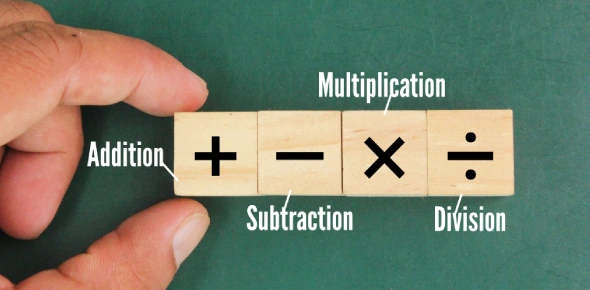Basic Operations Addition, Subtraction, Multiplication, Division & Fractions
Lesson Overview
- What Are Basic Operations in Math?
- Why Is Division With Remainders Important?
- How Do You Subtract Decimals Accurately?
- What Happens When You Multiply a Decimal by a Whole Number?
- How Do We Add Mixed Numbers?
- How Can Fractions Be Simplified?
- What Is a Fraction of a Whole Number?
- Developing Critical Thinking: When Should You Use Which Operation?
- Table of Basic Operation Skills
- Self-Check Questions
- Key Takeaway:
Imagine trying to build a LEGO structure without knowing which pieces fit together. That's how math feels without understanding basic operations. Students often struggle with solving even simple problems because the foundation-the four key operations-isn't clear.
This lesson will help students master addition, subtraction, multiplication, division, and fraction operations so they can confidently solve problems and build a stronger math foundation.
What Are Basic Operations in Math?
Basic operations in math include addition, subtraction, multiplication, and division, and they are often extended to fractions and decimals. These are the building blocks of all higher math.
Why Is Division With Remainders Important?
Division is the process of splitting a number into equal parts. But what happens when you can't divide evenly?
Example from quiz: What is 3,705 ÷ 4?
- Step 1: 4 goes into 37 nine times (9 × 4 = 36).
- Step 2: Subtract 36 from 37, get 1.
- Step 3: Bring down 0 to make 10. 4 goes into 10 two times (2 × 4 = 8).
- Step 4: Subtract to get 2, bring down 5. 4 goes into 25 six times (6 × 4 = 24).
- Step 5: Remainder is 1.
Answer: 926 R1.
Why it matters: Understanding remainders is key when dealing with real-life scenarios like sharing objects equally among people.
How Do You Subtract Decimals Accurately?
Subtracting decimals requires aligning digits correctly.
Example: 14 – 2.73
- Align decimal points:
14.00
− 2.73
= 11.27
Key Concepts:
- Always align the decimal points vertically.
- Add zeroes if needed to match decimal places.
Common Question: "What if the numbers don't have decimals?"
Answer: Add ".00" to whole numbers to align easily.
What Happens When You Multiply a Decimal by a Whole Number?
Multiplying decimals is about ignoring the decimal point initially and adjusting afterward.
Example: 14.5 × 7
- Ignore the decimal: 145 × 7 = 1,015
- Add back the decimal: One place → 101.5
Real-Life Link: Calculating cost (e.g., $14.50 for 7 items).
| Decimal × Whole Number | Result |
| 3.2 × 4 | 12.8 |
| 2.5 × 3 | 7.5 |
| 5.75 × 2 | 11.5 |
How Do We Add Mixed Numbers?
Mixed numbers are whole numbers combined with fractions.
Example: 1 1/3 + 2 2/9
- Convert to improper fractions:
1 1/3 = 4/3, 2 2/9 = 20/9 - Find LCM (Least Common Multiple) of 3 and 9 → 9
4/3 = 12/9
20/9 stays the same - Add: 12/9 + 20/9 = 32/9
- Simplify to mixed number: 3 5/9
What Students Ask: "Why convert to improper fractions?"
Answer: It makes it easier to find a common denominator and add properly.
How Can Fractions Be Simplified?
Simplifying fractions means expressing them in their lowest form.
Example: 20/30
- GCD (Greatest Common Divisor) of 20 and 30 is 10.
- 20 ÷ 10 = 2, 30 ÷ 10 = 3 → Answer: 2/3
Why it matters: Simplified fractions are easier to compare, compute, and apply.
| Original Fraction | GCD | Simplified |
| 18/24 | 6 | 3/4 |
| 16/40 | 8 | 2/5 |
| 30/45 | 15 | 2/3 |
What Is a Fraction of a Whole Number?
This tells us how many parts of a number we have.
Example: What is 1/5 of 100?
- 100 ÷ 5 = 20
Key Tip: Multiply the whole number by the numerator, divide by the denominator.
Formula:
ab×c=a×cb\frac{a}{b} \times c = \frac{a \times c}{b}ba×c=ba×c
Example:
23×60=1203=40\frac{2}{3} \times 60 = \frac{120}{3} = 4032×60=3120=40
Developing Critical Thinking: When Should You Use Which Operation?
Scenario 1: You are at a store and buy 5 pens, each costing $2.75.
→ Multiply: 5 × 2.75
Scenario 2: You baked 36 cookies and want to divide them among 8 friends.
→ Divide: 36 ÷ 8 = 4 R4
Scenario 3: You spend $3.25, $2.80, and $1.95 on snacks.
→ Add: Total spent
Scenario 4: You have $10, and you spend $6.25.
→ Subtract: $10 − $6.25
Key Thinking Question:
"Can more than one operation apply to a problem?"
Yes. Multi-step problems often require more than one operation.
Table of Basic Operation Skills
| Operation | Key Idea | Common Mistake to Avoid |
| Addition | Line up digits or decimals | Forgetting to carry over |
| Subtraction | Borrow carefully with decimals | Ignoring decimal placement |
| Multiplication | Multiply digits, count decimal places | Misplacing the decimal point |
| Division | Use long division, understand remainders | Ignoring the leftover or remainder |
| Fractions | Simplify using GCD | Dividing only numerator or denominator |
| Mixed Numbers | Convert before adding or subtracting | Not using common denominators |
Self-Check Questions
- If 1/4 of a pizza costs $2.50, how much does the whole pizza cost?
- What is 6.2 + 3.15?
- Simplify 12/18.
- If a rope is 24 feet and you cut it into 5 equal parts, how long is each?
- Multiply 3.4 × 2
Key Takeaway:
Mastering basic operations empowers students to solve real-world problems confidently. Whether it's shopping, cooking, or solving schoolwork, these skills provide the mathematical foundation for more complex learning. Understanding the why behind each method builds confidence and fluency in math.
Take This Quiz
Rate this lesson:
 Back to top
Back to top
